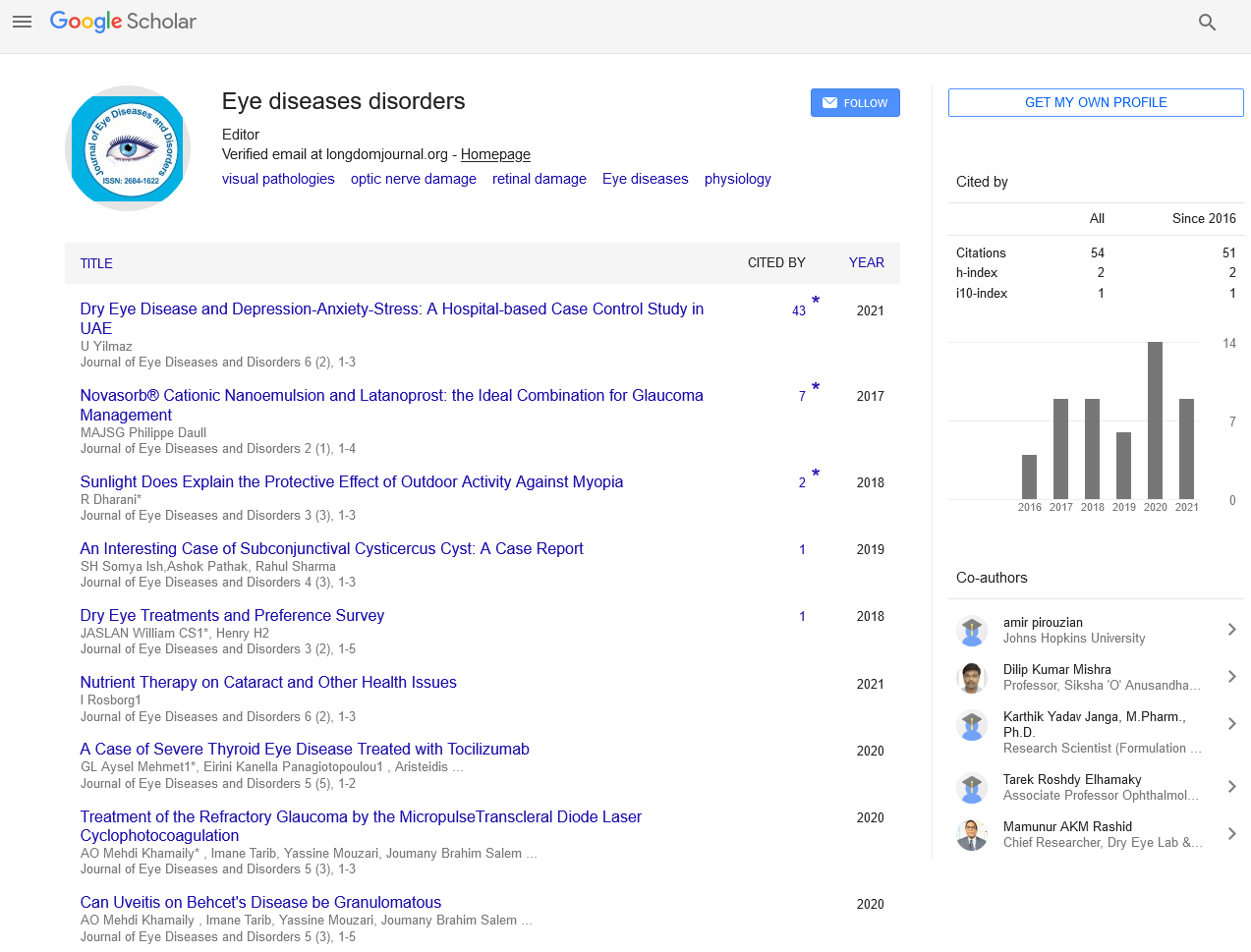Indexed In
- RefSeek
- Hamdard University
- EBSCO A-Z
- Geneva Foundation for Medical Education and Research
- Euro Pub
- Google Scholar
Useful Links
Share This Page
Journal Flyer
Open Access Journals
- Agri and Aquaculture
- Biochemistry
- Bioinformatics & Systems Biology
- Business & Management
- Chemistry
- Clinical Sciences
- Engineering
- Food & Nutrition
- General Science
- Genetics & Molecular Biology
- Immunology & Microbiology
- Medical Sciences
- Neuroscience & Psychology
- Nursing & Health Care
- Pharmaceutical Sciences
Research Article - (2019) Volume 4, Issue 2
A Homemade Herbal Beer Containing 15 Eye-Beneficial Herbs Designed for Glaucoma Patients and People with Bad Eye Circulations
Johnson K Gao*Received: 11-Jul-2019 Published: 02-Aug-2019
Abstract
The blood supply of eyeball is mainly depending on a very thin central retinal artery and circulates back to the small vein, both of them are located in the center of the ocular nerve cord at the back of the eyeball, which is rather similar to a cherry fruit attached to a tiny stalk. It is an unreasonable design for our eye nutritional supply. The very thin central retinal artery with the diameter less than 1/5 mm is too heavy a burden to transport oxygen and nutrients to keep a well maintenance of the delicate retina, especially in the computer era with excessive radiation damage of the eyes. When the aged process goes on and the malnutrition status happens, such that high fatty food diet and wastes deposition onto the capillaries, that may cause blood vessels having micro-capillary clots forming, which is a subclinical blockage or narrowing of the diameter of those small arteries, veins and capillaries, that are rather difficult to detect. Although the currently clinical methods for curing glaucoma using eye drops and surgery to reduce the intra ocular pressure are in practice, it might be even more important to concern how to improve a good microcirculation of eyes. Many traditional Chinese herb medicines had practiced through thousand years and verified to have good effects on blood circulation and they are beneficial to eye-health. Small amount of alcohol, but not over dose, may help blood vessel relaxation. Hop in beer is a good antioxidant, which eyes are welcome. This is a try to formulate a DIY 15-herb extract enhanced beer to see if that drink could become an extra helper in healthy eye maintenance or to reduce glaucoma, AMD progress.
Keywords
Age-related macular degeneration (AMD); Herbal beer; Glaucoma patients; Retina
Introduction
Don't think that everything in our body is naturally reasonable. The retina of eyes is one of the highest energy users and oxidation required tissues. But, the blood supply of the whole eyeball is mainly dependent on a very thin central retinal artery and circulates back to the small vein, both of them are located in the center of the ocular nerve cord at the back of the eyeball, which is rather similar to a cherry fruit attached to a tiny stalk. I feel it is an unreasonable design for our eye nutritional supply. The very thin central retinal artery, which has a diameter less than 1/5 mm, is too heavy a burden to transport oxygen and nutrients to keep a well maintenance of the delicate retina. There might not be severe problems as for keeping the normal physiological condition of the eye. In the ancient time of human being, the natural selection for the eye development of our ancestors’ eyes was only facing the wild plane or forest, and most of objects to be seen were far and less radiation emission. So we may say that the evolution of eye-blood supply is relatively reasonable to the human being in ancient time. But, now, in the computer age, our eyes are facing the excessive exposure to the radiation damage generated by computer screens and other electronic devices. Our eyes have met the new problem of bad blood circulation and malnutrition status than ever before. Besides the modern food industry provides us with varieties of tasteful high fatty diets and also food-coloring dies, which contain lake-dye (the un-indicated aluminum compounds in the food labels), and most of pizza bases and cakes also have aluminum, that can cause protein crosslinking and are very harmful to the brain. Those wastes will easily deposit onto the blood vessels and capillaries that may cause undetectable micro-capillary clots forming, which is the subclinical blockage or narrowing of the diameter of those small arteries, veins and micro capillaries. So, our eyes may always under the condition of malnutrition and suffocation. To my understanding, to help a good microcirculation could be more important than to the use of eye drops alone in order to suppress the intra ocular pressure in glaucoma patients or in age-related macular degeneration (AMD) patients.
Experimental
After extensive reading of both the English and Chinese literature related to the treatment of glaucoma and age-related macular degeneration, I published an article: Use Three Herbal “Bullets” to Shoot Glaucoma. In that paper I stated: “the central retinal artery is 163 μm in diameter [1]. It is so narrow a neck like a sand-timer that can’t let enough blood flow to nourish the delicate retina cells. The retinal blood flow was 38.1 μl/min. That means approximately 0.038 ml/min, or 54.72 ml/day. If the average blood volume of an adult is 5,000 ml, use 5,000 divided by 54.72 ml/day, it produces 91.37 days”. That means in order to let the nutrients you absorbed from foods, which are evenly distributed in your whole blood, you need to wait three months.
The inadequate eye structure for blood supply reminds me of an old story. About 60 years ago, when I was a graduate student at the university, I did many experiments to produce three-eyed tadpoles. That was for my master degree thesis called as “Induction of lens by presumptive retina”. By microsurgery to graft eye bubble from other embryonic donor, I could make a third eye growing on the back of the head or even on the trunk of the host tadpole body. From the evolutionary point of view, human being was not created by god in one day, but, through many billion years’ evolution on the Earth. In the amphioxus, which is the earliest ancestor of all vertebrates, there is no real eye as our human being does. (See a quotation: amphioxus’s has no true brain, but have two dark, pigmented spots on the front of their "heads" that are thought to be precursors of the vertebrate eyes) [2]. In most vertebrates the embryonic eye formation are very similar. For an example, in the frog eyedevelopmental stages [3] the first step is the ectoderm on the back of the embryo folding inside to form the neuronal tube (Stage 14-16). The second step is the projection of two eye bubbles bilaterally near the front head (Stage 17-18) and then the outer layer of eye bubble concaves to form the eyecup.
The third step is the interaction between the eyecup and its outer epidermis to induce the later to become the presumptive lens (Stage 19-20), and the fourth step is the lens induces its outer layer epidermis to form the cornea (Stage 21). While the eye blood vessels are developed not from the ectoderm but from the mesoderm. So, the origin of an eyeball is a mixture of both epidermal and mesodermal two embryonic layers. The entire mechanism of mutual inference, or, induction between the presumptive retina and the presumptive lens vesicle might be still unknown until today. The recent research reported that the bone morphogenetic protein (BMP) signals have been shown to play important roles during eye formation. That a finding confirms my suspicion some 60 years ago, that although the retina can induce the epidermis to form lens, the lens is also important to the maintaining of a normal retina [4]. If in the adult man the lens will still secrete certain types of protein that is similar to the BMP in maintaining normal health of retina, then a question may raise that patients after cataract removal of the lens and implanted the intra ocular artificial lens the chance of glaucoma and AMD to happen will be increased a lot higher. To interfere with the human being’s embryonic eye development experimentally, it is almost impossible based on the current technology. Thus, to find some ways to increase the microcirculation of the adult eye to adept the computer era’s multiple radiation situations will be a tough task to ophthalmologists. However, the traditional Chinese medicine (TCM) had cumulated a lot of useful knowledge on herbs that may either to relax blood vessels, or, nourish the liver and kidney, which in turns to nourish the eye. Thus, I formulated a 15-herb extract enhanced beer, with which it may cast certain hope to help glaucoma and AMD patients as compensation to the currently used western drugs and surgical methods.
During my visit to a wine company (Bouche) in Champagne, France, I got an idea to use wine or beer enhanced with Chinese herb extracts to nourish the eyes. When I got back to Garland TX, I home made a 15 Chinese herb extract enhanced Pilsner Urquell beer, which I believe is the King of beers with light color and good hops, which is good for eyes due to its antioxidant as well. I tried my specially crafted homemade beer. Personally, I feel my herbal enhanced beer is good to improve my vision. Then, I wrote an article of my invention for publication. Now, I give the name of that kind of beer as "Gao's 15 herbs extract enhanced beer for eye nutrition”. I intend to let glaucoma patients and IT men to try that method and to use that beer. Of course, to an uncertified product, the risk is yours to try. Here I propose a home-made beer containing 15 herbs, which may help to the improvement of blood circulation and eye nutrition, thus to restore retinal cells’ vitality and normal function. The English and Chinese names of those herbs and their amount used are listed below.
Materials
One aroma oil: Boswellia extracted oil (fragrance) 1 ml
Two leaves: (Dragon Well) Green tea (Icha) 21 g
Lotus leaf (The leave of the Nelumbo nucifera, Lotus leaf) 20 g
Three roots: Ginseng root (Ginseng) 10 g
Salvia root (Salvia) 16 g
Turmeric (ginger) 16 g
Four seeds: Wolfberry (Go Ji berry) 20 g
Schisandra seeds (Five flavors) 6 g (using 0.05 g baking soda to reduce its acidic)
Semen Cassiae(Cassia) 20 g
Gardenia jasminoides (Huang Wei) 10 g
Five flowers: Saffron (Saffron) 3 g
Panax notoginseng flower (Sanqi flower) 16 g
White chrysanthemum (chrysanthemum) 16 g
Coreopsis tinctoria (snow chrysanthemum, Snow daisy) 16 g
Dandelion flower (Dandelion flower) 10 g
Each of these herbs has at least has one or more functions to add benefit to the eye, either it can dilate the blood vessels, increase the blood flow, or, it can cause the brightening of the vision, or, to nurse the neuron, or, it is good for the heart, or, it has the ability of scavenging free radicals, or, it can kill bacteria or mold and enhance immune system, or, it can decrease pain and increase wound-healing. I will not cite literature of individual herbs. People can easily search their English names through http://google.com, or, the Chinese names through http://baidu.com. Among those herbs, it is worthy to [5,6] give few citations to saffron, and Gardenia jasminoides.
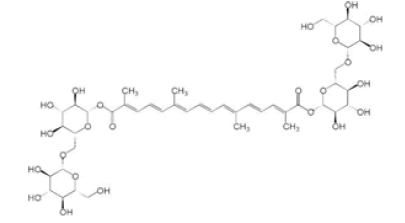
Saffron contains water-soluble crocin [7] which is in yellow color and is water soluble. Crocin has many double bonds like lutein.
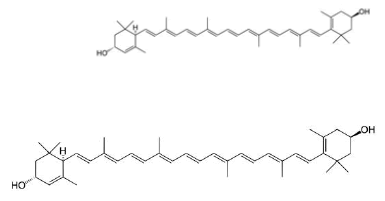
Lutein is needed by macula. But, lutein is difficult to be dissolved in water. I guess that crocin is much easier to be transported in blood than lutein and its double bonds can mimic lutein in retina for free radical damage protection. Thus, I use those herbs.
Preparation
All of 15 herbs above were cut to small pieces if necessary, such that lotus leave, and crush them to smaller size in a crusher through several grouped operations. Mix them well. The total weight is about 200 g. Stuff them in 5-7 of large Japanese empty tea bags (Daiso brand, 11.0 × 10.5 cm) and follow the instruction for self-sealing of the tea bag. Then, those herb tea bags were put in a porcelain jar (Out diameter and height are about 12 × 17 cm, with a rubber-ring sealing lid). Pour 400 ml of “EVERCLEAN” 190 proof grain alcohol (=95% alcohol concentration) (Figure 1) in to that jar, soaking for several hours.
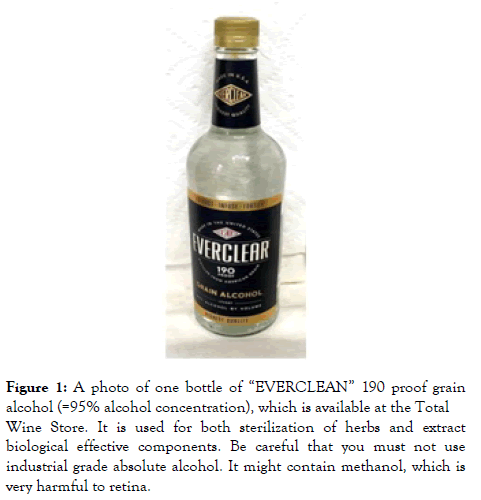
Figure 1. A photo of one bottle of “EVERCLEAN” 190 proof grain alcohol (=95% alcohol concentration), which is available at the Total Wine Store. It is used for both sterilization of herbs and extract biological effective components. Be careful that you must not use industrial grade absolute alcohol. It might contain methanol, which is very harmful to retina.
That procedure can kill most of bacteria. Then, after the completing the sterilization, transfer the wetted tea bags and the liquor into a stainless bowl. Wash the jar with spring water to get rid of debris. Put back the wetted herb tea bags into the jar. Filter the liquor, which had turned into brownish tea color, passing through a coffee-maker nylon filter. Measure the volume of that liquor and add more “EVERCLEAN” alcohol to it to bring back the total amount of 400 ml. Pour that alcohol back to the jar and further extraction for 3-7 days, with occasionally swirling the jar. The color of the extract is showing in (Figures 2 and 3). Store it in a refrigerator. Since the density of the concentrated alcohol is lower than the water, the sediment of fine particles is easier to form, leaving a dark brown herbalcoholic extract on the top for future use.
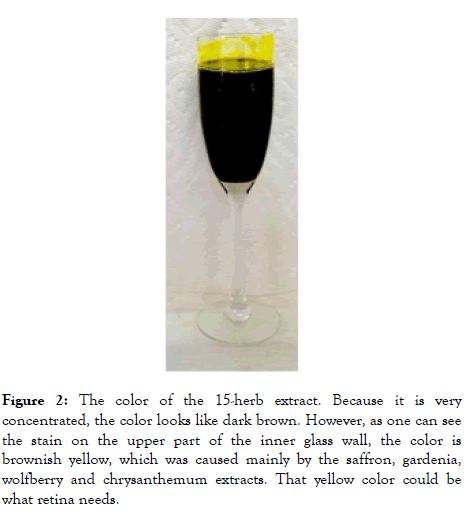
Figure 2. The color of the 15-herb extract. Because it is very concentrated, the color looks like dark brown. However, as one can see the stain on the upper part of the inner glass wall, the color is brownish yellow, which was caused mainly by the saffron, gardenia, wolfberry and chrysanthemum extracts. That yellow color could be what retina needs.
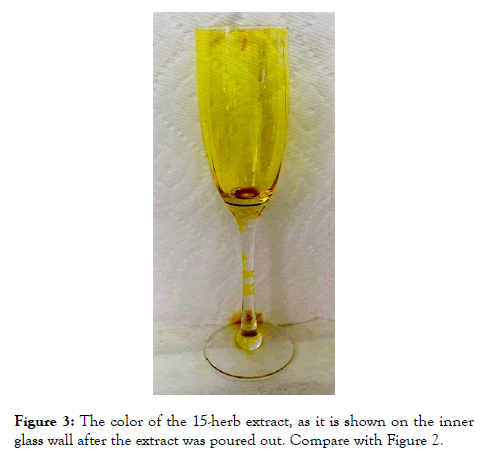
Figure 3. The color of the 15-herb extract, as it is shown on the inner glass wall after the extract was poured out. Compare with Figure 2.

Usage
Select the brand of beer that you preferred to drink. Add the 15- herb alcoholic extracts in the amount of 10 to 20 ml to every 500 ml of beer. The beer that I selected is Pilsner Urquell (Figures 4 and 5). To a bottle of 330 ml beer, alcohol concentration 4.4%, you can add 6 ml of herb extract. Mix it well and drink it. (Figures 6 and 7) are photos of beer, beer plus herb extract and herb extract in water. See description in the legend. It is said that small amount of beer can relax blood vessels and increase blood flow. But, constant and over dosage beer drink may harm to the circulation system. The hop flower in the beer is a kind of antioxidant and bacteria preventer, which may be good for eyes as well.
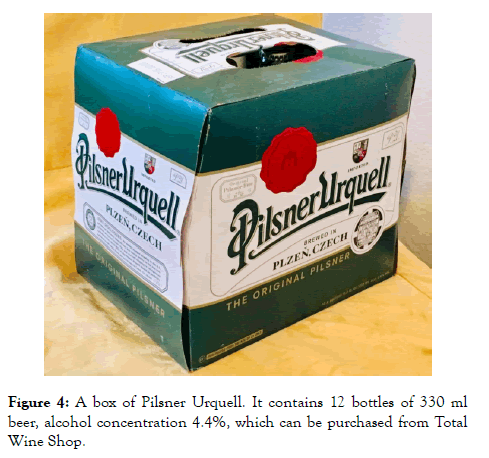
Figure 4. A box of Pilsner Urquell. It contains 12 bottles of 330 ml beer, alcohol concentration 4.4%, which can be purchased from Total Wine Shop.
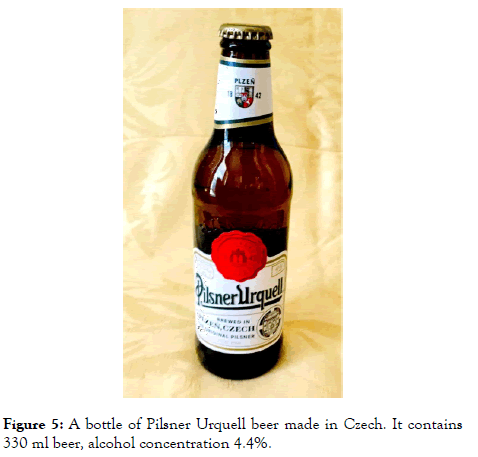
Figure 5. A bottle of Pilsner Urquell beer made in Czech. It contains 330 ml beer, alcohol concentration 4.4%.
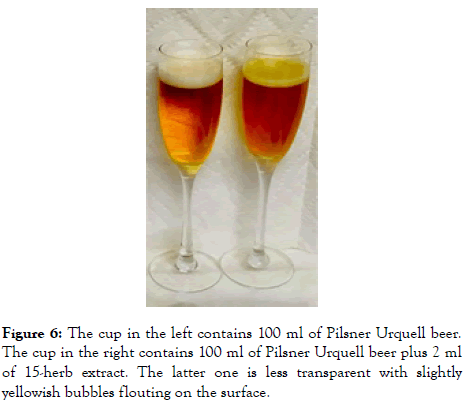
Figure 6. The cup in the left contains 100 ml of Pilsner Urquell beer. The cup in the right contains 100 ml of Pilsner Urquell beer plus 2 ml of 15-herb extract. The latter one is less transparent with slightly yellowish bubbles flouting on the surface.
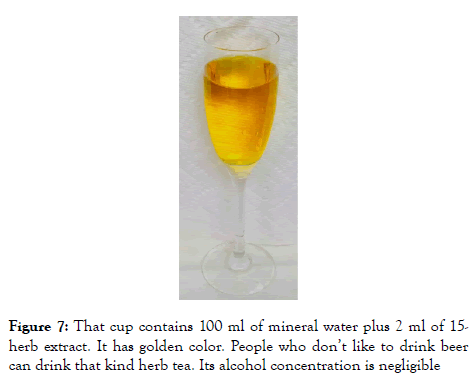
Figure 7. That cup contains 100 ml of mineral water plus 2 ml of 15- herb extract. It has golden color. People who don’t like to drink beer can drink that kind herb tea. Its alcohol concentration is negligible
In case that people don’t want to use alcoholic drinks, then, he/she may use mineral water to preplace the beer and get an herbal tea (Figure 7). Honey or sugar or sweetener may be added to that herbal tea, as he/she prefers. Pregnant and breast-feeding women and people allergic to any mentioned herb shall not use that drink. It is users’ risk to try making and drinking that kind of beer or tea. For commercial production according to Gao’s recipe or its modification, one must contact with the author in advance.
Conclusion
Although the currently used eye-drops and surgical methods for the treatment of glaucoma, which were based on the hypothesis that glaucoma is mainly caused by raised intraocular pressure, some of glaucoma patients do not show high intraocular pressure and certain people exist higher intraocular pressure but they do not cause glaucoma. And certain glaucoma patients after several laser procedures to decrease intraocular pressure, but their eye condition is still going worse. The author rose a new suspecting that the death of retinal cells could be more directly related to the sub clinically diagnosable bad microcirculation and mal-nutrition of retina cells. Since many traditional Chinese medicines (herbs) that had already verified through thousands of years of human being practice that they are either having the function of increase of blood circulation, helping wound healing, or, doing scavenge to free radicals (antioxidants). The low concentrations of alcohol can dilate blood vessels. The hops in the beer belong to the antioxidant also.
The author based on his knowledge and experience formulated the 15-herb extract enhance beer to let people try. This is just a research proposal only. The effectiveness and side effects of the method are waiting to be clarified. People who plan to try that method bare the risks by themselves. This method has not gone through clinical try. The effectiveness and its side reaction are not certified. People use this method to make beer on their own risk. Pregnant women and breastfeeding women should not use it. For those who want to get a label for their beer bottle may use the following label (Figures 8 and 9). Make a copy of this article is permitted. For commercial production of this beer or its modifications shall contact the author in advance.
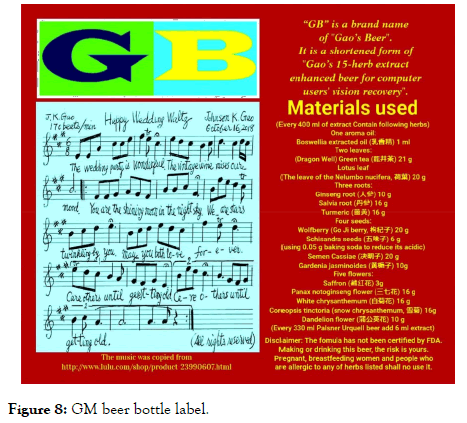
Figure 8. GM beer bottle label.
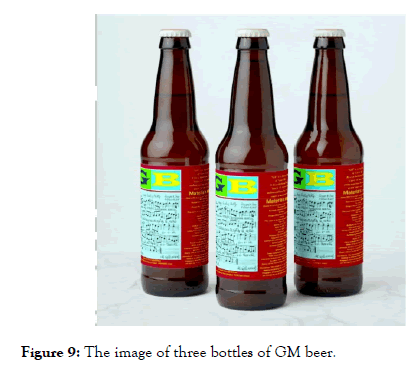
Figure 9. The image of three bottles of GM beer.
REFERENCES
- Johnson KG. Use three herbal “bullets” to shot glaucoma. J Clin Ophthalmol Eye Disord. 2018; 2(2):1-3.
- Vopalensky P, Pergner J, Liegertova M, Benito-Gutierrez E, Arendt D, Kozmik Z. Molecular analysis of the amphioxus frontal eye unravels the evolutionary origin of the retina and pigment cells of the vertebrate eye. Proc Natl Acad Sci U S A. 2012; 109(38):15383–15388.
- Virginia Herpetological Society. Amphibian Development Charts. 2019.
- Pandit T, Jidigam VK, Patthey C, Gunhaga L. Neural retina identity is specified by lens-derived BMP signals. Development. 2015; 142:1850-1859.
- Picardi M, Marangoni D, Minnella AM, Savastano MC, Valentini P, Ambrosio L, et al. A longitudinal follow-up study of saffron supplementation in early age-related macular degeneration: Sustained benefits to central retinal function. Evid Based Complement Alternat Med. 2012; 2012:1-9.
- NDTV FOOD. Health benefits of saffron (kesar) for skin and health. 2018.
- Crocin. Wikipedia. 2019
Citation: Gao JK (2019) A Homemade Herbal Beer Containing 15 Eye-Beneficial Herbs Designed for Glaucoma Patients and People with Bad Eye Circulations. J Eye Dis Disord 4:127. Doi: 10.35248/2684-1622.19.4.127
Copyright: © 2019 Gao JK, et al. This is an open-access article distributed under the terms of the Creative Commons Attribution License, which permits unrestricted use, distribution, and reproduction in any medium, provided the original author and source are credited.
